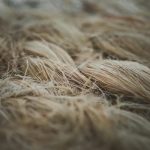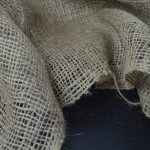You might wonder if acetate is natural or synthetic; it’s actually semi-synthetic. That’s because acetate starts with natural cellulose, usually from wood pulp, but goes through chemical changes to become fiber. So, it bridges the gap, combining nature’s base with man-made processing. It looks and feels silky but requires careful care since it’s sensitive to heat and moisture. Keep exploring to discover more about its unique features, benefits, and how it compares to other fibers.
Table of Contents
Key Takeaways
- Acetate fiber originates from natural cellulose extracted from wood pulp, a renewable plant-based resource.
- It undergoes chemical modification via acetylation, transforming cellulose into cellulose acetate fiber.
- Acetate is classified as a semi-synthetic fiber, combining natural origins with significant chemical processing.
- Unlike fully synthetic fibers, acetate starts with natural materials but is chemically altered to create the final product.
- Its unique production places acetate between natural fibers and synthetic fibers in classification.
Understanding the Origins of Acetate
Although acetate fiber often feels natural, it actually starts with wood pulp, a renewable resource.
When you think about fibers, you might assume acetate comes directly from plants like cotton or linen. Instead, you’re working with a material derived from cellulose extracted from wood.
This cellulose provides the base, making acetate different from fully synthetic fibers, which are usually petroleum-based.
Because it begins with a natural substance, acetate holds a unique place between natural and synthetic fibers. You get the benefit of a plant-based origin, but the fiber itself isn’t found in nature.
Understanding this origin helps you appreciate why acetate has qualities like softness and sheen, often resembling silk, yet is created through processes that alter the natural cellulose to form the final fiber.
The Chemical Process Behind Acetate Production
You start by extracting cellulose from natural sources like wood pulp.
Then, through an acetylation reaction, the cellulose transforms into cellulose acetate.
Finally, you regenerate the fiber to create the acetate material used in textiles.
Cellulose Extraction Source
Cellulose, the key raw material for acetate fiber, comes primarily from wood pulp and cotton linters.
When you source cellulose, you rely on plant fibers rich in this natural polymer. Wood pulp is extracted from trees through mechanical and chemical methods that break down the lignin and hemicellulose, leaving behind almost pure cellulose.
Cotton linters, the short fibers remaining on cotton seeds after ginning, offer another excellent cellulose source. Both materials undergo purification to remove impurities like waxes and proteins.
This purified cellulose is essential because it directly influences the quality and consistency of the acetate fiber produced.
Acetylation Reaction Process
Three key steps drive the acetylation reaction process that transforms purified cellulose into acetate fiber.
First, you treat the cellulose with acetic anhydride, which introduces acetyl groups to the cellulose molecules. This reaction replaces some hydroxyl groups, altering the cellulose’s properties.
Next, you add a catalyst, usually sulfuric acid, to speed up the reaction and guarantee the acetyl groups bond effectively.
Finally, you carefully control temperature and reaction time to optimize the degree of substitution—how many hydroxyl groups convert to acetate. This balance is essential because it affects the fiber’s solubility, strength, and flexibility.
Fiber Regeneration Method
Although the acetylation reaction modifies cellulose, the fiber only takes shape through the fiber regeneration method. This process dissolves the acetylated cellulose in a solvent, then extrudes it through tiny spinnerets to form fine filaments. These filaments solidify into acetate fibers, ready for textile use. You’ll appreciate how this method bridges natural raw materials with synthetic techniques, creating a versatile semi-synthetic fiber. Here’s a quick look at the emotional journey acetate undergoes during regeneration:
| Stage | Feelings Evoked | Visual Imagery |
|---|---|---|
| Dissolution | Transformation | Cellulose melting |
| Extrusion | Creation | Filaments emerging |
| Solidification | Renewal | Fiber taking form |
This chemical artistry gives acetate its unique blend of natural origin and engineered performance.
Natural Cellulose: The Base Material for Acetate
When you look closely at acetate fiber, you’ll find that its foundation lies in natural cellulose, a complex carbohydrate derived from plants.
Cellulose forms the structural framework in plant cell walls, making it abundant in sources like wood pulp and cotton linters. By extracting cellulose, manufacturers obtain a renewable raw material that’s both biodegradable and sustainable.
This natural base is essential because it provides the chemical backbone for acetate production. Without cellulose, acetate fiber wouldn’t exist as it depends on chemically modifying cellulose molecules.
What Makes a Fiber Synthetic or Natural?
Since acetate fiber starts with natural cellulose, you might wonder whether it counts as natural or synthetic.
The key difference lies in how the fiber is made. Natural fibers come directly from plants or animals without significant chemical changes. Synthetic fibers, on the other hand, are created entirely through chemical processes from petrochemicals.
Acetate falls somewhere in between. You start with natural cellulose, but you chemically modify it to produce the fiber. This means acetate isn’t purely natural nor fully synthetic.
Acetate blends natural cellulose with chemical processing, making it neither fully natural nor entirely synthetic.
When deciding if a fiber is natural or synthetic, consider its source and the extent of processing. If you see heavy chemical alteration, it leans synthetic. Minimal processing keeps it natural.
Acetate’s semi-synthetic nature comes from this blend of natural origin and chemical transformation.
Characteristics of Acetate Fabric
You’ll notice acetate fabric is made from cellulose combined with chemicals, giving it a unique fiber composition.
It feels smooth and has a silky appearance that often mimics natural fabrics.
When it comes to durability and care, you’ll want to handle it gently to keep it looking its best.
Fiber Composition Details
Acetate fiber combines the look and feel of natural silk with the easy-care properties of synthetics, giving you a unique fabric choice.
Its composition originates from cellulose, a natural polymer found in wood pulp, which is chemically processed and transformed into cellulose acetate. This semi-synthetic process means acetate isn’t purely natural nor fully synthetic.
When you wear acetate, you’re experiencing a fiber created by modifying natural materials to enhance durability and luster.
It’s important to know that acetate fibers contain about 92% cellulose acetate, with the remainder made up of additives that improve processing and performance.
This blend gives acetate its characteristic strength, breathability, and ability to hold vibrant dyes, making it versatile for various apparel and home textiles without sacrificing comfort.
Texture and Appearance
While exploring fabric options, you’ll notice that acetate stands out for its smooth, silk-like texture and lustrous finish. When you touch acetate, you’ll feel a soft, almost glossy surface that mimics the elegance of natural silk.
Its sheen catches light beautifully, giving garments and upholstery a vibrant, polished look. You’ll also appreciate how acetate drapes gracefully, enhancing the flow and movement of whatever it’s used for.
Unlike some synthetic fibers that can feel stiff or plastic-like, acetate offers a luxurious hand that feels comfortable against your skin. Its appearance can range from shiny to slightly matte, depending on how it’s woven or finished, allowing you to find the perfect look for formalwear, linings, or decorative fabrics.
Durability and Care
Because acetate fibers are sensitive to heat and moisture, you’ll need to handle them with care to maintain their appearance and longevity. Avoid high temperatures when washing or ironing, and steer clear of prolonged exposure to sunlight. Proper care helps prevent wrinkles, shrinking, and color fading.
Here’s a quick guide for caring for acetate fabric:
| Care Aspect | Recommendation |
|---|---|
| Washing | Hand wash or use a delicate cycle |
| Drying | Air dry flat, avoid direct sunlight |
| Ironing | Use low heat, preferably with a cloth |
| Stain Removal | Blot gently, avoid harsh chemicals |
Comparing Acetate to Other Semi-Synthetic Fibers
When you explore semi-synthetic fibers, you’ll notice they blend natural and chemical processes to create versatile materials.
Acetate, like rayon and lyocell, starts with cellulose but undergoes different chemical treatments. Compared to rayon, acetate has a silkier feel and resists wrinkles better, making it popular for linings and formalwear.
Acetate begins with cellulose and offers a silkier feel and better wrinkle resistance than rayon, ideal for linings and formalwear.
Lyocell, on the other hand, offers greater strength and moisture absorption, often used in activewear.
Acetate’s unique appeal lies in its glossy finish and vibrant dye uptake, setting it apart in aesthetics. However, it’s less durable than lyocell and more sensitive to heat than rayon.
Understanding these differences helps you choose the right fiber based on your fabric needs, balancing appearance, care, and performance.
Environmental Impact of Acetate Production
Although acetate comes from natural cellulose, its production involves chemical processes that impact the environment in various ways. You should know that producing acetate requires chemical solvents and energy-intensive steps, which can lead to pollution and resource depletion. Wastewater from the process may contain harmful chemicals, affecting ecosystems if not treated properly. However, acetate’s biodegradability offers some environmental benefits compared to fully synthetic fibers.
| Environmental Aspect | Impact Level | Notes |
|---|---|---|
| Chemical Use | Moderate | Uses acetic anhydride and solvents |
| Energy Consumption | High | Energy-intensive processing |
| Waste Generation | Moderate | Requires careful wastewater handling |
| Biodegradability | Positive | Breaks down faster than synthetics |
Understanding these factors helps you assess acetate’s environmental footprint realistically.
Common Uses of Acetate in the Textile Industry
Since acetate offers a silky appearance and excellent drape, you’ll often find it used in linings, dresses, and blouses.
Its smooth texture makes it perfect for formal wear and evening gowns where a luxurious feel is desired. You’ll also see acetate in scarves and ribbons because it holds vibrant colors well, enhancing visual appeal.
In home textiles, acetate appears in upholstery and drapery fabric, adding elegance and sheen. Additionally, acetate’s ability to mimic silk allows manufacturers to produce affordable alternatives without sacrificing style.
When you handle acetate garments, you’ll notice their lightweight nature and soft touch, which adds to comfort.
Benefits and Drawbacks of Acetate Fabric
You’ll find acetate fabric offers a smooth finish and vibrant colors that make your clothes stand out.
However, it’s not as durable as some other fibers and can wrinkle or melt under high heat.
Let’s explore these benefits and limitations to see if acetate fits your needs.
Advantages of Acetate
When you choose acetate fabric, you benefit from its vibrant sheen and smooth texture that mimic silk without the high cost. It drapes beautifully, making your garments look elegant and sophisticated.
Acetate resists shrinking and stretching, so your clothes maintain their shape longer. You’ll also appreciate that it dries quickly, which is handy for laundering. Plus, acetate is quite lightweight and breathable, keeping you comfortable in warmer weather.
It accepts dyes well, so you can enjoy rich, vivid colors that stay bright over time. Another advantage is its affordability compared to natural silk, making it accessible without sacrificing style.
Limitations of Acetate
Although acetate fabric offers many appealing qualities, it comes with some notable limitations you should consider before choosing it for your wardrobe. It’s prone to wrinkles, can weaken when wet, and may not stand up well to high heat, so you need to handle it with care. Additionally, acetate can attract static and may fade when exposed to sunlight for long periods. Understanding these drawbacks helps you decide if acetate fits your needs.
| Limitation | Impact on Use |
|---|---|
| Wrinkles easily | Requires frequent ironing |
| Weak when wet | Avoid heavy washing or soaking |
| Heat sensitive | Low-temperature ironing only |
| Static build-up | May cling uncomfortably |
| Sunlight fading | Not ideal for prolonged outdoor use |
How to Care for Acetate Clothing
Because acetate fibers are delicate, you should handle your acetate clothing with care to maintain its appearance and longevity.
Always check the care label before cleaning. Most acetate garments require dry cleaning to prevent damage, but some can be hand-washed gently in cold water with mild detergent.
Avoid wringing or twisting; instead, press out excess water carefully. When drying, lay the item flat on a clean towel away from direct sunlight or heat sources to prevent shrinking or distortion.
Iron acetate on a low heat setting with a pressing cloth to avoid melting or shiny spots.
Store acetate clothes in a cool, dry place, ideally hanging or folded loosely to reduce wrinkles.
Taking these steps helps preserve the fabric’s smooth texture and vibrant colors over time.
Innovations in Acetate Fiber Manufacturing
As demand for sustainable and high-performance textiles grows, manufacturers have introduced several innovations in acetate fiber production to meet these needs.
You’ll find that new solvent recovery systems now reduce environmental impact by recycling chemicals used in processing. Plus, advances in spinning technology let you produce finer, stronger fibers with improved moisture management, enhancing comfort and durability.
Some producers have also developed bio-based cellulose sources, making acetate fibers more eco-friendly without sacrificing quality.
You can benefit from these improvements because they result in fabrics that not only look luxurious but also perform better in wear and care.
The Future of Semi-Synthetic Fibers in Fashion
When you explore the future of semi-synthetic fibers in fashion, you’ll see they’re set to play a major role in combining sustainability with style.
You’ll find innovations targeting eco-friendly production methods, reducing chemical use, and improving biodegradability. As brands and consumers demand greener alternatives, fibers like acetate will gain popularity for their renewable origins and versatile properties.
You can expect more blends that enhance durability and comfort while minimizing environmental impact. Plus, advances in recycling technologies will let you recycle semi-synthetic garments more efficiently, closing the loop in fashion’s circular economy.
Frequently Asked Questions
Can Acetate Fabric Cause Skin Allergies or Irritation?
You might experience skin irritation or allergies from acetate fabric, especially if you have sensitive skin. It can trap heat and moisture, causing discomfort. Always test a small patch first to see how your skin reacts.
Is Acetate Biodegradable or Recyclable?
Think of acetate like a fading star—it doesn’t disappear quickly. You’ll find it’s only partially biodegradable and tricky to recycle, so you’ll want to handle it thoughtfully to keep the planet shining bright longer.
How Does Acetate Fabric Feel Compared to Cotton or Silk?
You’ll find acetate fabric feels smooth and silky, similar to silk but lighter. Compared to cotton, it’s less breathable but has a shiny, luxurious touch. It drapes well, making it great for elegant clothing.
Does Acetate Shrink When Washed?
Imagine you wash your acetate blouse in hot water; you’ll likely notice some shrinking. Acetate fibers can shrink if exposed to heat, so you should always wash them in cold water and air dry to keep their size intact.
Can Acetate Be Blended With Other Fibers?
You can definitely blend acetate with other fibers like cotton, polyester, or silk. This mix improves durability, comfort, and appearance, giving you versatile fabrics that combine the best qualities of each fiber for your clothing needs.
- The Most Breathtaking Guipure Lace Wedding Dresses of [Current Year - June 25, 2025
- What to Look for When Buying a Guipure Lace Wedding Gown - June 25, 2025
- Boho to Ballgown: Finding the Perfect Guipure Lace Bridal Style - June 25, 2025







